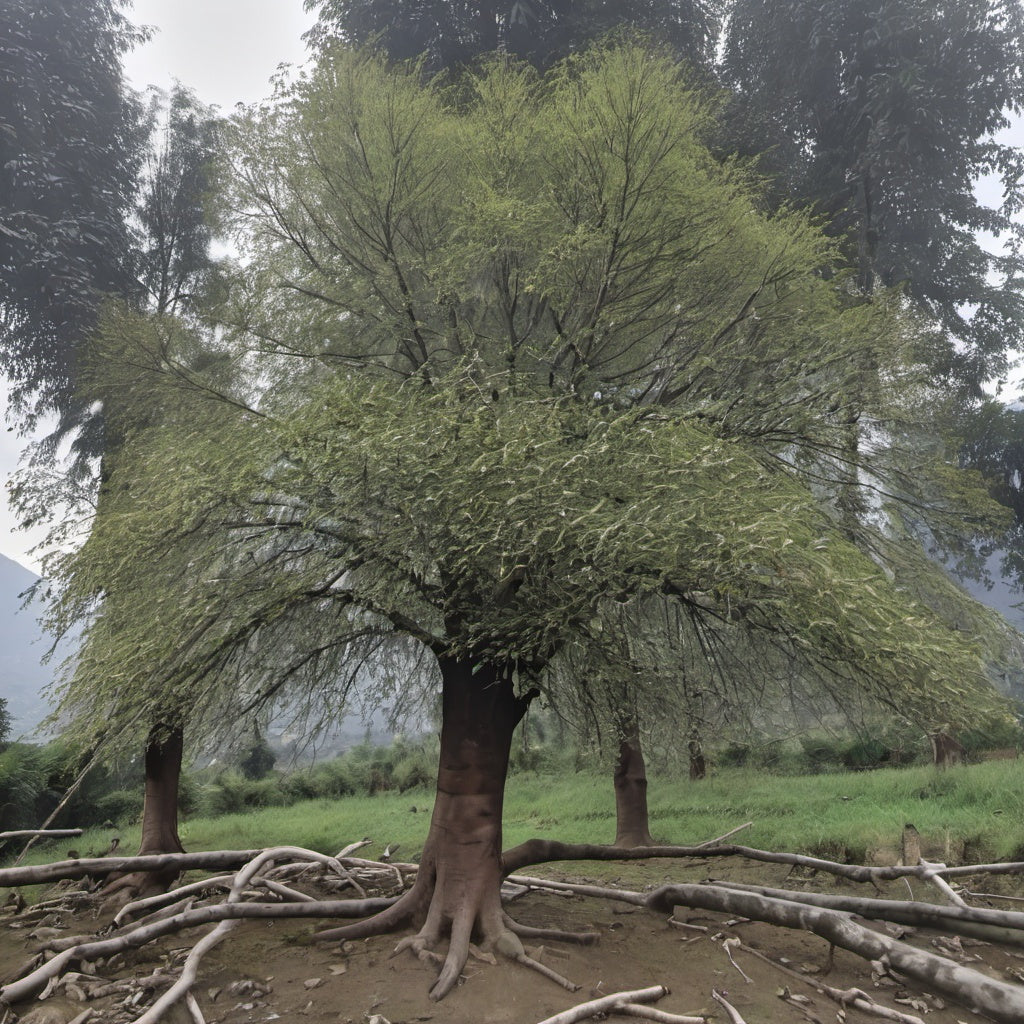Nepal Alder Tree Seeds
Nepal Alder Tree Seeds
Couldn't load pickup availability
Nepal Alder Tree Seeds
(Alnus nepalensis)
Alnus nepalensis, commonly known as the Nepal Alder, is a fast-growing deciduous tree native to the Himalayas and other regions of South and Southeast Asia, such as Nepal, Bhutan, India, and Myanmar.
1. Botanical Characteristics
- Family: Betulaceae (birch family)
- Height: It typically grows between 60-90 feet tall, although it can reach up to 100 feet in favorable conditions.
- Leaves: The leaves are broad, ovate to elliptic, about 7-15 cm long, with serrated edges. They are bright green and turn yellowish in the autumn.
- Bark: The bark of the tree is smooth, light gray, and can have horizontal lenticels, often peeling in thin flakes.
- Flowers: The tree is monoecious, meaning it has both male and female flowers on the same tree. The male flowers appear in long catkins (5-15 cm), while the female ones are short, woody cones.
- Fruit: The fruit is a small, woody cone that disperses tiny winged seeds when mature.
2. Habitat
Nepal Alder grows predominantly in the mid to high altitudes (1,500 to 9,000 feet) in the Himalayan region, thriving in moist and disturbed soils, including riverbanks, landslide zones, and forest clearings. It is adaptable to both tropical and temperate climates.
3. Ecological Importance
- Nitrogen Fixing: Like other species of Alnus, it has a symbiotic relationship with a nitrogen-fixing bacterium called Frankia. This helps enrich the soil with nitrogen, improving soil fertility, which benefits other plant species in the area.
- Erosion Control: Its extensive root system helps to stabilize soil, making it useful in controlling erosion, particularly in mountainous and hilly regions.
- Habitat: The tree provides habitat and food for various bird species and insects.
4. Uses
- Timber: The wood of the Nepal Alder tree is light and soft, and though not highly durable, it is used locally for making furniture, plywood, and construction material.
- Fuelwood: The tree is often cultivated for firewood due to its fast growth.
- Traditional Medicine: In some regions, parts of the tree are used in traditional remedies. For example, its bark is sometimes used for treating certain skin conditions.
- Agroforestry: Due to its nitrogen-fixing ability, it’s used in agroforestry systems to enhance soil fertility and support the growth of crops.
5. Cultural Significance
In some cultures, especially in the Himalayan region, the tree is associated with regeneration and resilience, often growing rapidly in areas affected by landslides or other natural disturbances.
Zones: 7 to 9
Stratification Requirement: 30 days cold moist stratification
Planting Instructions:
Seed preparation is essential for successful germination. Before sowing, soak the seeds in water for 24 hours to soften the outer coat and improve germination rates. Then could moist stratify the seeds for 30 days.
To cold-moist stratify Nepal Alder tree seeds for 30 days, begin by gathering the necessary materials, including the seeds, moist seed-starting mix, a plastic ziplock bag or airtight container, and a refrigerator set to a temperature range between 1-5°C (33-41°F). Cold stratification mimics the natural winter dormancy period the seeds require to break dormancy and germinate successfully.
Start by preparing the moist medium. Dampen the seed-starting mix with distilled water, ensuring that it is moist but not overly saturated. This moisture will help keep the seeds hydrated without causing rot. Next, mix the Nepal Alder tree seeds evenly with the moistened medium to ensure the seeds are exposed to consistent moisture throughout the stratification process. Once mixed, place the seeds and medium into a ziplock bag or airtight container.
Seal the bag or container securely, making sure to label it with the date, seed type, and the start of the stratification process. Place the sealed bag in the refrigerator, where the temperature will remain consistently cool between 33-41 degrees. Leave the seeds in the refrigerator for a full 30 days, periodically checking to ensure the medium remains adequately moist. If the medium dries out, gently re-moisten it, and if it becomes too wet, allow excess moisture to escape.
After 30 days, remove the seeds from the refrigerator. They should now be ready for sowing. Plant the seeds in seed trays or small pots filled with well-draining soil and keep them in a warm, sunny location. The cold stratification process will have broken the seeds' dormancy, giving them the best chance to germinate once exposed to suitable growing conditions.
First, choose a location with well-drained, moist soil, as the Nepalese Alder thrives in environments with ample water availability. This tree prefers altitudes ranging from 500 to 3,000 meters and does well in regions with temperate to subtropical climates. The soil should ideally be slightly acidic to neutral (pH 5.5-7.5), and fertile enough to support healthy growth. However, Nepal Alder can also tolerate poorer soils due to its nitrogen-fixing ability, which enriches the soil over time.
Prepare a seedbed or use seed trays filled with a well-draining seed-starting mix. Scatter the seeds evenly on the surface and lightly press them into the soil, but do not bury them deep as they require light for germination. Keep the seedbed in partial shade and maintain consistent moisture by misting the surface regularly.
After germination, which typically occurs within two to four weeks, the seedlings should be carefully nurtured. Once the seedlings develop their first true leaves and are strong enough to handle, they can be transplanted into individual pots or directly into the field. Ensure that the young plants receive enough water but avoid waterlogging, as this could cause root rot. Over time, they should be gradually introduced to full sunlight. Proper care during the early stages of growth, including protection from pests and strong winds, will help establish a robust root system, making them resilient for later transplantation into their final growing site.
Share


